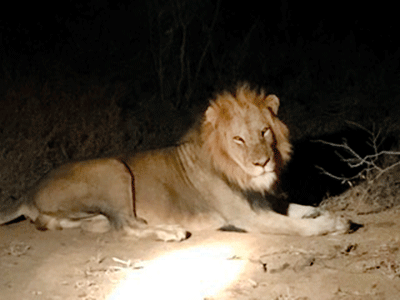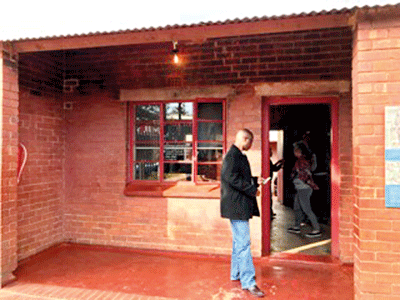Glimpses of dark political chapter and jungle beauties

Entrance to the Mandela House in Soweto (left) and the king of the jungle encountered at night at the Kapama game reserve (above)
The rainbow colours of the South African flag are symbolic of the multi-cultural nation of South Africa that has emerged since Apartheid was lifted in 1994. Scientists have established that South Africa was an important centre for the evolution of human civilization. It was inhabited by Australopithecines since at least 2.5 million years ago. Modern human settlement occurred around 125,000 years ago in the Middle Stone Age.
The two Portuguese explorers to discover the coastline of South Africa were Bartolomeu Dias and Vasco da Gama. The Dutch established the Dutch East India Company in 1652, a year after they discovered the country and used South Africa as a stopover for their ships. Jan van Riebeeck and his French wife established a colony near Cape Town. The discovery of gold and diamonds led to the Boer wars between the Boers and the British Empire. The Union of South Africa was established and became a self-ruling colony in 1934. From 1948 to 1994 Afrikaner nationalism dominated the nation.
Pretoria is the administrative capital and Johannesburg the financial capital and the gateway to the South. Presently, Parliament sits at the beginning of the year for six months in Cape Town and the balance period in Pretoria. The population of South Africa is 58 million and predominantly Christian. There are no disagreements on religious lines and Africans still practise their ancestral beliefs. English is one of the eleven national languages. The literacy rate is 28% and the unemployment rate 35%.
The country has made strides since independence in 1994 and Nelson Mandela served one term as President and relinquished his position to younger members of the party. The grace of the man was that after being imprisoned for 27 years he forged an alliance with the then President F. W de Klerk and took the nation forward without acrimony.
South Africa is rich in minerals, manufactures textiles and cars, has a strong agricultural background and is reliant on tourism. Conservation is zealously guarded and there are stringent punishments for poachers.
Crime is a drawback and most of the houses in the residential areas have electric fencing and security guards. However I was told that crime in the Johannesburg area had lessened as a result of tougher police measures. The tourist areas of Cape Town have CCTV cameras and police patrols.
The tour I booked commenced in Johannesburg. The highlights were the visit to the Apartheid Museum designed by an architectural consortium depicting the seven pillars of the new constitution at the entrance and Mandela’s words “To be free is not merely to cast off one’s chains but to live in a way that respects and enhances the freedom of others”. Tickets indicate which entrance (whites or non-whites) one enters through reminiscent of the segregation that existed.
At the entrance were figures of the early settlers encased in glass who came to the country during the gold and diamond rush. Well documented are the lives of those ANC forefathers who took part in the struggle–their lives and the movement in their words and finally the process of reconciliation. We spent a fascinating morning reliving that dark chapter, seeing a mock-up of the cell on Robben Island, and saw the Red Mercedes presented to Nelson Mandela by the Mercedes Benz workers amongst other items on display.
Soweto, the First Township for blacks, was established in 1904. Workers had to walk to work. We lunched on typical African food at a local restaurant, practically next door to Archbishop Emeritus Desmond Tutu’s home. We walked through Mandela’s red brick matchbox home on Vilakazi Street, which he shared with Winnie Madikizela Mandela prior to being on the run and finally imprisoned. The bullet marks in his house are still visible. In his words he described his return:
“That night I returned with Winnie to No. 8115 in Orlando West. It was only then that I knew in my heart I had left prison. For me No. 8115 was the centre point of my world, the place marked with an X in my mental geography.”
The Hector Pieterson memorial and the incident where 147 people were murdered in an uprising against education in the Afrikaans language was another landmark with Tutu’s Regina Mundi church a stone’s throw away. The attention of the world on these and subsequent uprisings resulted in economic and cultural sanctions being imposed on the country.
The following day an internal flight took us to Nelspruit airport near the Kruger Reserve. We were driven past scenic countryside to Kapama Southern Camp stretching across 13,000 hectares for our three-day safari. Kapama is a private game reserve, a luxury lodge with 56 discreetly hidden thatched huts and recreation areas set amidst the solitude and flowering plants of the jungle. Impala, warthogs wander past and I nearly bumped into a huge Gnu, who was eating leaves when I ventured out at 5.30 a.m. for the game drive!The Roode family owns the reserve. Our knowledgeable ranger Philip and vigilant tracker, Alec gave us an unforgettable experience.
On our first game drive a leopard crossed the road and was soon camouflaged in the thicket. We chanced upon lions and lionesses within touching distance. The animals had just finished mating and the flirtation continued before bedtime. Mating takes place 15 times a day and once the mating period is over the lioness is left to fend for herself.
As we drove through the African bush with its tawny grass, twisted tree trunks some with thorns, others with leaves a masterpiece of beauty, with the moon rising in the background, occurred. Our ranger was informed that there had been a sighting of a lion in the area. We paused, waited and heard the roar. Suddenly over the ridge appeared a magnificent beast majestically walking towards our open vehicle. Our ranger adeptly pulled aside and the ‘king of the jungle’ slunk past within touching distance of my friend, who jumped onto her neighbour’s lap. The animal continued undaunted marking his territory. We followed in the vehicle until he veered into the brush.
In a different area that same night, as we were driving back, we came across another lion asleep on the road. We waited until the animal awoke, stretched and yawned. He was waiting to meet with his brother. Lions can hear up to 30 kms and his ears twitched as he waited for a signal. He suddenly turned his head impressively and squinted in our direction, then arose and followed his brother’s scent spraying the bushes.
We learnt that the brothers and their stepbrother had an alliance and were fighting their father for supremacy of the pride. The father had lost an eye in a battle with his sons and had fled northwards. At a future date, these lions would fight each other for leadership. Lions in the wild live between ten to twelve years and females longer.
There were further sightings of two lionesses lying in the bush with their cubs, their bellies bursting after a kill. Another lioness stalked a giraffe that stood watchfully until the lioness walked away with her young realising this giraffe was not easy game. Giraffes are susceptible to lion kills with their awkward gait.
 Amidst the jungle protected by a ring of trees are the water holes and rivers where the animals drink. At the river, we were able to see the outline of a pod of Hippos lazing in the water protecting their thin skins against the sun. A mother and her baby disturbed from their nap on land by the arrival of intruders hastened into the water and mother opened her large jaws to warn us. The hippo is a treacherous animal to encounter and there are 400 human deaths a year. Their life span is 35 years.
Amidst the jungle protected by a ring of trees are the water holes and rivers where the animals drink. At the river, we were able to see the outline of a pod of Hippos lazing in the water protecting their thin skins against the sun. A mother and her baby disturbed from their nap on land by the arrival of intruders hastened into the water and mother opened her large jaws to warn us. The hippo is a treacherous animal to encounter and there are 400 human deaths a year. Their life span is 35 years.
As we drove within the reserve, we came across numerous giraffe feeding in the thickets. Their thick eyelashes protect their eyes from the thorns. We watched two male giraffes sparring knocking their long seven vertebrae necks against each other.
A large herd of savannah buffaloes considered dangerous passed by led by a pathfinder who indicates the feeding areas and movement. The older buffaloes trail back or find retirement zones near watering holes. The red-billed oxpeckers were perched on their backs, de-ticking and sound a warning if they sensed danger.
There was a herd of thirty elephants at a drinking hole and another group moved into the brush on sighting us followed by the larger African bull at a distance. There were sightings of Impala, bushbuck, warthogs, wildebeest, baboons, a pack of hyenas, vultures and white rhinos who are short sighted. A dazzle of Burchells zebras were out in full force and shied away at the sound of the vehicle. The zebras are not workhorses but the males have a strong neck and the females a large stomach for pregnancies. The male covers the female’s urine when she is pregnant protecting her.
During our game drives in the morning, we paused for hot chocolate with marshmallows at scenic spots prior to breakfast witnessing Egyptian Geese, and Ibis. In the still of the evening, we relaxed with sundowners and finger food watching the sunset.
Some of the group visited a Cheetah breeding centre in the area and saw other animals that had lost their mothers to poachers and were suffering from trauma.
(Part 2 next week)


